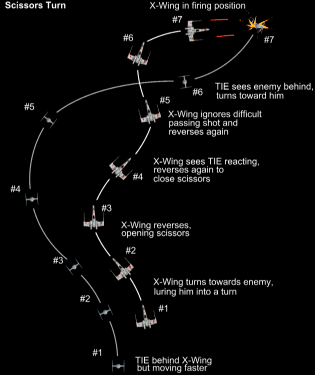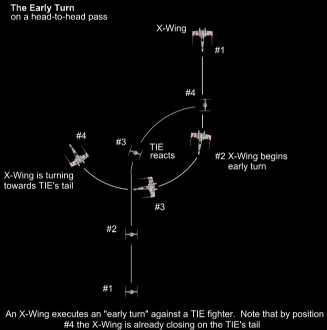Basic Combat Maneuvering
Tactical Operations Briefing 6
By Lieutenant Andy "Predator" Furlán, Rogue 10 (retired)
Predator stood calmly at the podium. "We'll get started as soon
as everyone's here..." He stopped in mid sentence as a pilot walked
in, "which would appear to be now. Settle down and we can get started".
"Today we will discuss various aspects of dogfighting. We will
cover certain key elements and review tactics employed in such encounters.
Any questions before we begin?"
A young Flight Officer tentatively raised his hand, "Sir? I haven't
been in all that many engagements, what should I expect?"
"First, each dogfight is unique to the situation at hand. No two
encounters will ever be exactly alike. However, each of these engagements
will share certain characteristics. Fighters will share such features
as speed, maneuverability and firepower. What we can not plan for
is how any enemy pilot will behave. Remember two things: it is the
pilots who determine the outcome of every dogfight, and there is
never just one way to defeat your opponent. So, how can we truly
be prepared? For one thing we can train, using proven tactics and
maneuvers."
"Lieutenant Furlán?" interrupted another flight officer.
"You mentioned certain key elements in a dogfight..."
"Yes, the essential rule in dogfighting is to get on the enemy's
tail. On all fighter craft, blaster cannon and missile guidance
systems only face forward. If you're on the enemy's tail, you can
shoot and he cannot. If you can't get on his tail, at least try
to place his craft ahead of you as much as possible, so you have
the maximum number of firing opportunities."
"Maintaining a higher speed and maneuverability is also valuable
in a dogfight. A fighter slower and less agile can only dodge attacks.
A fighter faster and more agile can attack or retreat as desired."
"What do we do when the enemy is behind us?"
"That's a good question. If the enemy is behind you, there are
various escape maneuvers: Turning Inside, the Scissors, the Immelman,
and the Yo-Yo." Hearing a bit of laughter from his fellow pilots,
Lieutenant Furlán said "And no, for those of you who are
wondering, I didn't name these myself."
"Not only do I expect you understand and utilize these maneuvers,
but also to recognize these maneuvers so you can apply the appropriate
counter-maneuver. Is that clear?"
"Yes sir." came the reppling response.
"The first maneuver we will review today, is known as Turning Inside.
This is the simplest solution to an enemy craft coming up behind
you. Simply turn toward him. If you're turning faster than he, you'll
gradually circle around and get onto his tail. Of course, if the
enemy is turning faster than you, he will eventually come around
behind you. If this happens, my advice to you is: Try something
else immediately. The longer you wait the worse it gets, until he
lines you up in his sights and blasts you up."
"Any questions on this maneuver?" asked Lieutenant Furlán,
waiting for a response. He got none. "OK, then we'll move on to
the next one."
"Very well. If you'll direct your attention to the light-table
besides me..." said Lieutenant Furlán as he pointed to a
flat, circular projection device. Reaching over to one of the touchboards
located around the table's edge.

A hologram of a single X-Wing and a TIE Fighter materialized above
the light-table. "A more complex way to out-turn an enemy spacecraft
is the Scissors maneuver. Begin a turn toward him, but once he begins
to turn with you, quickly roll over to turn in the other direction.
This opens the scissors. As the enemy realizes you've turned away
and turns toward you again, you reverse the procedure and roll back
toward him again. If your turns were quicker and tighter than his,
and/or you're on a slower craft, he will eventually pass in front
of you. This allows you to get onto his tail."
"Novice pilots trying to turn with you can be lured into a scissors
with ease. Even if their craft turn better, their slow reaction
to each scissors opening and closing will quickly give you the edge.
More experienced enemies may avoid this tactic by anticipating your
next turn and blast you (if they're less maneuverable), or by pulling
up and over in a yo-yo (if they're faster).
"Now let's go over it in detail, follow the holograms if you please".
"Now for the Immelmann Turn. Named after a veteran fighter pilot
of the Clone Wars, this maneuver is an excellent way to reverse
direction quickly. First you perform a half loop upwards to reverse
direction, then a half roll to right your spacecraft. If an enemy
is behind you, an Immelmann can bring you nose-to-nose with him."

"The Yo-Yo maneuver is used mainly by high speed craft against slower
opponents. This turn also requires excellent cockpit visibility, so
you probably won't find yourselves using this maneuver unless you're
in an A-Wing. For you Buccaneers, although you'll have little or no
occasion to use it in dogfighting, you may see enemy ships attempting
it against you!"

"In a Yo-Yo turn you climb and roll toward the enemy until he's
visible out the top of your canopy. Then pull over into a dive while
still turning. During the dive you roll your craft to help line
up your shot. Very often you'll end up taking the shot while inverted.
But hey! This is space, so don't let that bother you."
"Note that a Yo-Yo craft makes a very big turn in three dimensions.
But mostly in only two of these dimensions. That's why the best
defense against this maneuver is to reverse your turn, or use the
third dimension (usually using an Immelmann)."
"Excuse me sir, what if the enemy isn't on our tail, but coming
at us head to head?"
"Good question. There's a very useful maneuver when going on a
head-to-head pass, known only as The Early Turn. One of the most
difficult, but most useful tactics in a head-to-head pass is making
an Early Turn. Take a look at the hologram. Against inexperienced
pilots this trick is easy, since rookies usually keep going at you
hoping for a clear shot at you, and only thinking about a turn after
they've passed you. Against veteran pilots, an Early Turn requires
fine timing. If you turn more than a second or two ahead of the
enemy you're just telegraphing your intentions. If you wait too
long, you get no advantage at all."

"How do we know when to make the turn?"
"Like all of these maneuvers, they require long hours of practice
and fine tuning. Well, that's it. Thank you for your time gentlemen.
Dismissed!"